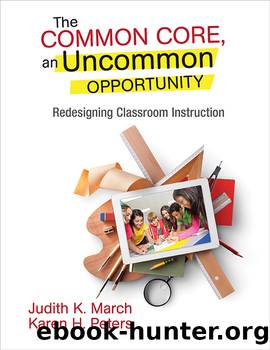The Common Core, an Uncommon Opportunity by March Judith K.;Peters Karen H.; & Karen H. Peters

Author:March, Judith K.;Peters, Karen H.; & Karen H. Peters
Language: eng
Format: epub
ISBN: 1534984
Publisher: Corwin Press
Published: 2014-08-15T00:00:00+00:00
3. Students are provided options or choices. Within each unit, students are provided choices among processes and/or products for the teaching-learning tasks as well as how to show authentic or performance mastery. For example, to show mastery of the U.S. Bill of Rights, students may decide to devise a lesson plan for younger children or write a letter to a cousin in England. They may get the information they need about the carbon dating from reading text or listening to an audio recording. In math, they may show mastery of 2- and 3-dimensional shapes by making pencil drawings or using nets to create and label various objects. To process the concept of irony, students may read several short illustrative snippets, or read a complete story by OâHenry (e.g., âThe Gift of the Magiâ).
But whichever choice they make, students are accountable to execute it with fidelity. At the core of both the new content standards and the 21st century skills is the expectation that students take responsibility for their own learning. It needs to begin in the classroom.
4. Common Core Literacy standards are included in science, social studies, and technical subjects (including math) for Grades 6â12. Until districts examine the Literacy standards (actually housed in the English Language Arts Common Core), there is a tendency to overlook them. But it is clear in the text of the English Language Arts (ELA) standards that the Literacy standards are to be authentically taught in social studies, science, and technical subjects, including math. Since many similarly worded standards are also included in ELA, it is strongly suggested that the four departments coordinate their efforts.
A summary of the Reading Literacy standards is shown in Table 4.6. The Science and Social Studies Reading standards are nearly identical, with a few technical differences. The directions for the Literacy standards make it clear that âtextâ does not refer to textbooks but to scholarly writing about science and social studies. These standards require students to analyze text in terms of technical language; the authorâs central ideas, purpose, and evidence (facts, judgments, hypotheses); the rhetorical structure of the piece; the use of quantitative and qualitative information; and the comparison and contrast of information from multiple sources. Many of the Math standards are similar, with the addition of listening to and critiquing peer explanations of reasoning; justifying math reasoning orally and in writing; and representing and interpreting data with and without technology.
For Writing, Table 4.7 shows the writing projects required in the Literacy standards for Science and Social Studies, but it also reflects the writing projects required of students in ELA. Since the Writing Literacy requirements for Social Studies and Science are spread across Grades 6â8, 9â10, and 11 and 12, districts can decide how best to distribute the instruction. But since the ELA standards require these writing projects at every grade level, there are obvious reasons to coordinate these efforts.
Table 4.6 Literacy Reading Skills
Download
This site does not store any files on its server. We only index and link to content provided by other sites. Please contact the content providers to delete copyright contents if any and email us, we'll remove relevant links or contents immediately.
The Art of Coaching Workbook by Elena Aguilar(50181)
Trainspotting by Irvine Welsh(21093)
Twilight of the Idols With the Antichrist and Ecce Homo by Friedrich Nietzsche(18329)
Fangirl by Rainbow Rowell(8823)
Periodization Training for Sports by Tudor Bompa(7950)
Change Your Questions, Change Your Life by Marilee Adams(7411)
This Is How You Lose Her by Junot Diaz(6479)
Asking the Right Questions: A Guide to Critical Thinking by M. Neil Browne & Stuart M. Keeley(5394)
Grit by Angela Duckworth(5328)
Red Sparrow by Jason Matthews(5233)
Paper Towns by Green John(4829)
Room 212 by Kate Stewart(4773)
Ken Follett - World without end by Ken Follett(4473)
The Sports Rules Book by Human Kinetics(4103)
Housekeeping by Marilynne Robinson(4093)
Double Down (Diary of a Wimpy Kid Book 11) by Jeff Kinney(3968)
Papillon (English) by Henri Charrière(3946)
The Motorcycle Diaries by Ernesto Che Guevara(3807)
Exercise Technique Manual for Resistance Training by National Strength & Conditioning Association(3803)
